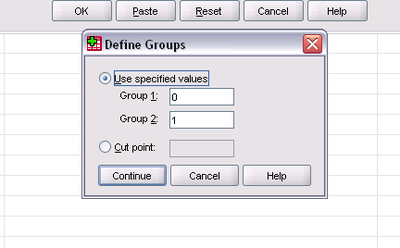Using SPSS and PASW/Independent Samples t-test
An independent samples t-test is used for comparing the means on an interval/ratio variable between two categories on a nominal/ordinal variable. It answers the question of whether the difference between means is statistically significant in the population of interest (assuming good sampling) or whether the difference is due to sampling error. To do this test, you need two variables from one population and sample. The independent variable is nominal/ordinal and the dependent is interval/ratio.
To illustrate this concept, this chapter tests to see if there is a statistically significant difference between whether or not Genetic Counselors believe in life after death and how spiritual they consider themselves.
To run the t-test you will click “Analyze” → “Compare Means” → “Independent Samples T-Test”:

Since the spirituality scale is the interval/ratio variable it will act as the dependent variable. That is, how spiritual one considers himself depends on his belief in life after death. Find the spiritual scale variable (labeled “sprscale”) and click the arrow to move it over to the test variable section. Next, find the views on life after death variable (labeled “postlife”) and click the arrow to move that over to the grouping variable section.
You will see question marks next to the grouping variable. This is because SPSS allows you to choose which categories of the independent variable you want to include (the variable could include more than just two categories). You will need to tell SPSS which groups to compare by clicking the “define groups” button. To find these labels, go back to the Data Editor in Variable View and click on the “Values” button for the “postlife” variable. You will see this screen:

The above screenshot shows that not believing in an afterlife is labeled “0” and believing is labeled “1.” Once you know what your values are for believing in an afterlife, return to the t-test dialog. In the define groups window, add zero for “No” and one for “Yes”:

Once you've defined your groups, click “Continue.” You'll return to the primary “Independent-Samples t-test” window:

Click OK, and SPSS will run the T-Test. Two tables will appear in the output:

A lot of information appears in these tables. The first table is simply the “Group Statistics” table, which includes: sample sizes, means, standard deviations and standard errors of the means.
The second table, labeled the “Independent Samples Test,” is what you use for determining whether or not you can reject the null hypothesis. Because you are comparing two means, two different variances are obtained. There is a long equation used to determine which variance to use, but SPSS does this for you by running the Levene’s Test for Equality of Variances. If the variances are relatively equal, that is one sample variance is no larger than twice the size of the other, then you can assume equal variances. By looking at the output of the Levene’s test you decide which row to use. If the significance is .05 or below, use the bottom row, or “equal variances not assumed.” If the significance is above .05 use the top row. In this example, since the significance is .000, we'll examine the bottom row.
Both the top and bottom row provide the same information, they just use different tests to calculate the test statistic, which results in slightly different calculations. This table provides the test statistic or t value, the degrees of freedom and other values helpful for determining confidence intervals. A key statistic provided is the p-value, listed in the “Sig (2-tailed)” column. If your p-value is greater than .05 you fail to reject the null (meaning the difference in means is likely due to chance or sampling error). If your p-value is less than .05 you can reject the null (meaning there is in fact a statistically significant difference in the means and it is not due to sampling error). In this case, you can reject the null hypothesis (because the significance is .000, which is substantially less than .05).
You should always interpret your analysis, “How spiritual someone considers him/herself is affected by someone's belief in an afterlife.”
Chapter contributed by Alison Moser.
